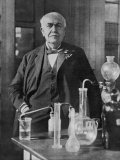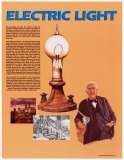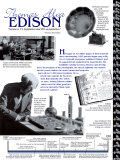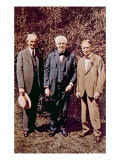Thomas Alva Edison Educational Posters, Art Prints, Photographs, Books, Videos, Links for Learning, pg 1 of 2
|
||||||||||||||||||||||||||||||||||||||||||||||||||
|
social studies > THOMAS ALVA EDISON POSTERS 1 | 2 < famous men < science |
||||||||||||||||||||||||||||||||||||||||||||||||||
|
Thomas Alva Edison Thomas Alva Edison was an American inventor who created, developed and/or refined many devises and applications of technology into mass production that influenced daily life in the 20th Century. Edison, a genius at experimentation and capable of great concentration of work effort, would probably have been considered a 'LD', or learning disabled child today. He apparently was unable to maintain attention in the classroom, and as a result was homeschooled by his mother, who "...was the making of me. She was so true, so sure of me; and I felt I had something to live for, someone I must not disappoint." Edison would later help support the fledging Montessori Method in the United States.
Edison's first patent was for an electric vote recorder in 1868 (shades of touch screens?), an adaptation of the telegraph, was followed by over 1,000 more US patents and many from the UK, France & Germany. It was Edison's invention and manufacturing of a successful phonograph - a device for recording and replaying sound, that earned him the moniker “Wizard of Menlo Park” from a newspaper reporter. Edison was responsible for the first commercially practical incandescent light bulb, and patented the first electrical power distributon system. Edison and inventor George Westinghouse were competitors in promoting Direct Current, (DC, Edison) and Alternating Current (AC, Westinghouse), as to which was the safest and most efficient. Edison was also friends with Henry Ford. (Did you know it was Nicola Tesla who developed fluorescent lighting?) FYI ~ Did you know the first words recorded by Edison (1877) was the nursery rhyme Mary Had a Little Lamb by Sarah Josepha Hale? |
||||||||||||||||||||||||||||||||||||||||||||||||||
THOMAS ALVA EDISON BOOKS, VIDEO, AUDIO Edison: A Life of Invention by Paul Israel -The conventional story of Thomas Edison reads more like myth than history: With only three months of formal education, a hardworking young man overcomes the odds and becomes one of the greatest inventors in history. But the portrait that emerges from Edison: A Life of Invention reveals a man of genius and astonishing foresight whose career was actually a product of his fast-changing era. In this peerless biography, Paul Israel exposes for the first time the man behind the inventions, expertly situating his subject within a thoroughly realized portrait of a burgeoning country on the brink of massive change. Informed by Israel's unprecedented access to workshop diaries, notebooks, letters, and more than five million pages of archives, this definitive biography brings fresh insights to a singularly influential and triumphant career in science. (Book Description) Edison: A Biography by Matthew Josephson - Regarded as the classic standard biography on Thomas Edison. It is the only biography written in the last 40 years to be recommended by the official voice of the caretakers of the Edison Laboratory National Monument in New Jersey which houses all of Edison's original records, sketches, notes, correspondence and memoranda. Depicts Edison as a pivotal figure in America's economic and industrial revolution success and at the same time as a human being, including his exploitative and, at times, crude qualities. (Product Description) At Work with Thomas Edison by Blaine McCormick - Thomas Edison is most often remembered as an ingenious inventor, however, history has overlooked the fact that he was also a talented businessman. "At Work with Thomas Edison" seeks to revive his forgotten business legacy by giving modern managers the tools they need to break loose from Corporate America's innovation-squelching mantra of efficiency, standardization, and control. Edison's techniques for raising capital, managing the process of innovation, and promoting radically new products were unsurpassed in his day. He became America's first high-tech entrepreneur by building an invention factory that spawned the phonograph, the light bulb, motion pictures, and much more. (Product Description) The Wizard of Sound - Chronicles the life and contributions of the inventor, from his sickly childhood to the creation of his own favorite invention, the phonograph. (Card Catalog Description) Fleet Fire: Thomas Edison and the Pioneers of the Electric Revolution by L J Davis - The electric revolution, which eclipsed the Industrial Revolution by the end of the 19th century and continues to this day, changed our world forever. FLEET FIRE tells us how it all began. In an engaging and entertaining narrative, L. J. Davis fields a cast of both prominent and forgotten characters, from dedicated scientists and mischievous rogues to enlightened amateurs who lit the sparks of discovery. Franklin's kite, Davenport's electromagnet, Morse's telegraph, Cyrus Field's transatlantic cable, and Edison's phonograph are but a few of the achievements Davis discusses. Explaining the science in lucid prose, FLEET FIRE conveys the arc of discovery during one of the most creative epochs in the history of mankind (Product Description) Inventing the Future: A Photobiography of Thomas Alva Edison - Thomas Edison’s 1,093 patented inventions include the light bulb, the phonograph, and significant contributions to the fields of photography and filmmaking and to what ultimately would become the national power grid. Edison’s gritty way of persevering—working ’round the clock with many assistants, catnapping on his lab table, trying things over and over again until he finally made a breakthrough—gave birth to the modern research laboratory, where hypotheses are proposed and then tested. Lively text, rare period photographs, Edison’s own words, and foreword by Edison’s great-grandson adds a personal note to this exciting American success story that will spark kids’ interest in science and inspire a new generation of inventors. (Book Description) Uncommon Friends: Life with Thomas Edison, Nenry Ford, Harvey Firestone, Alexis Carrell, and Charles Lindbergh - James Newton recalls a lietime of freindship all of them - a friendship that began when was only twenty years old and head of development of Edison Park in Fort Myers, FL. (Back Cover) Edison - The Invention of the Movies (1891-1918) DVD Edison: The Wizard of Light (2000) DVD LINKS FOR LEARNING : THOMAS ALVA EDISON
|
||||||||||||||||||||||||||||||||||||||||||||||||||
|
previous page | top | THOMAS ALVA EDISON POSTERS 1 | 2 |
|
|
|
NPW home | Global PathMarker Collection | APWTW Blog | faqs-about | contact | search | privacy |
|
NetPosterWorks.com ©2007-2015 The Creative Process, LLC All Rights Reserved. |
last updated











